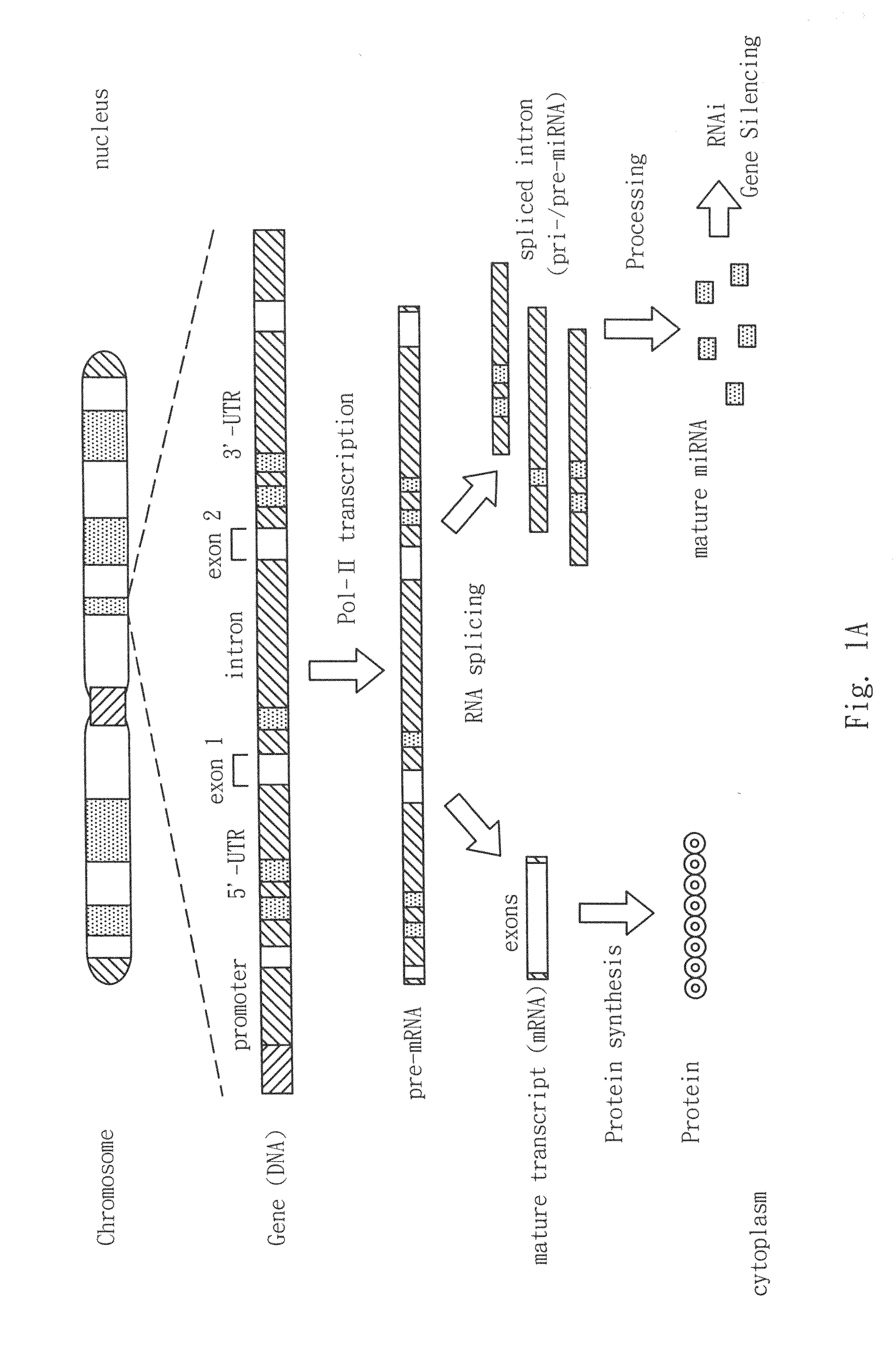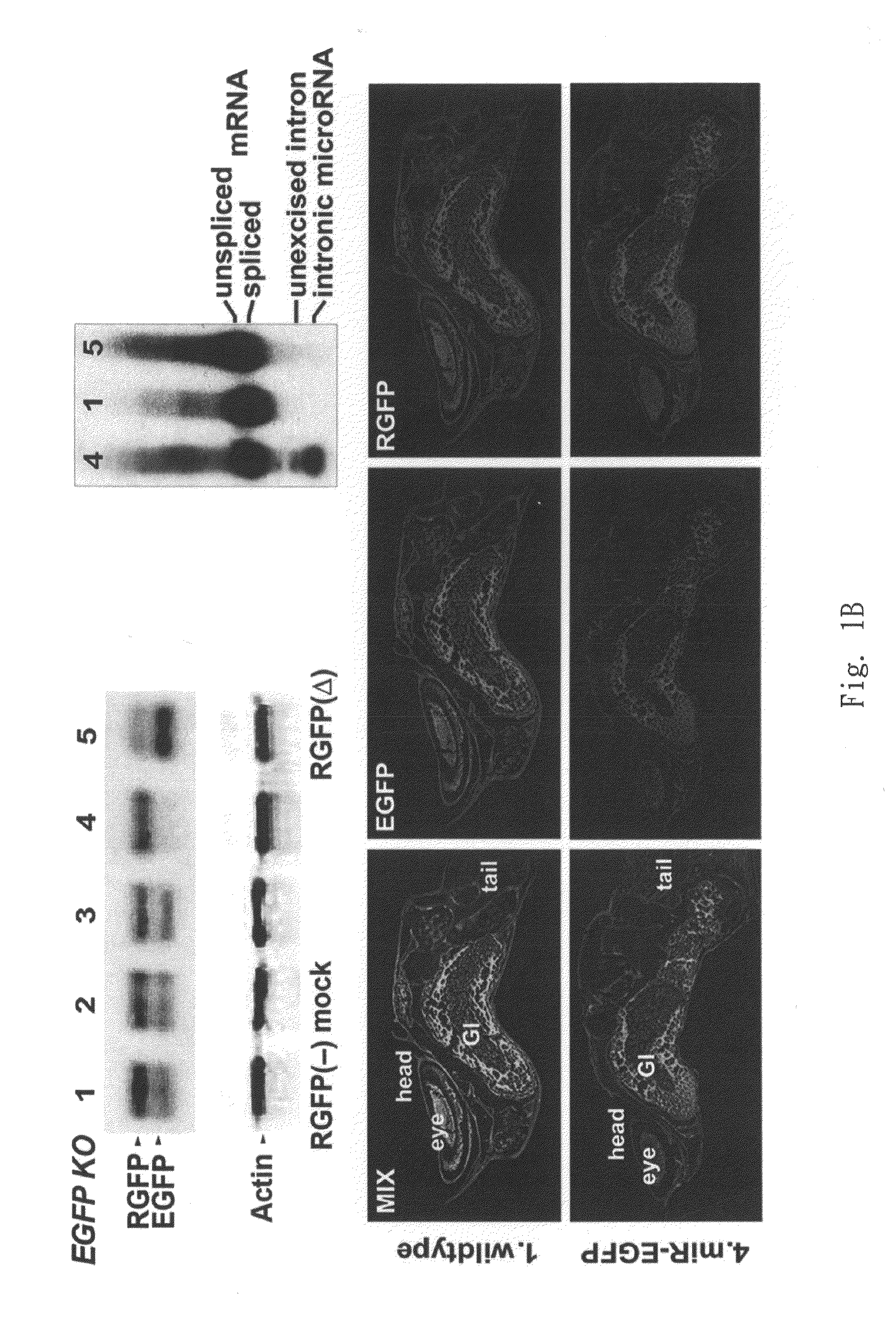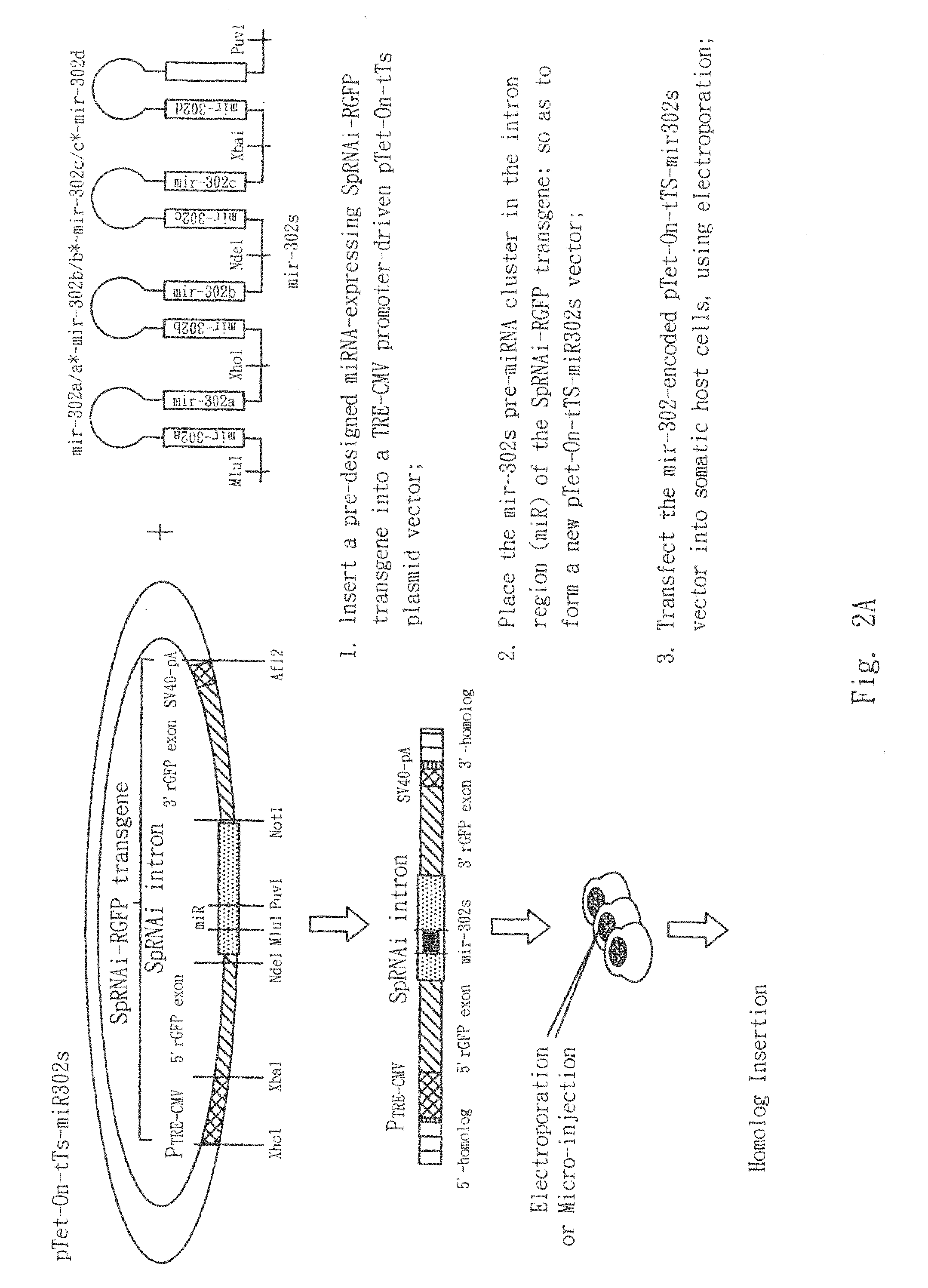Generation of tumor-free embryonic stem-like pluripotent cells using inducible recombinant RNA agents
a technology of recombinant rna and embryonic stem cells, which is applied in the field of developing, generating and selecting tumor-free embryonic stem (es)like pluripotent cells, can solve the problems of limited human stem cell cloning sources, difficult control of purity and quality, and problems in therapeutic safety and informed consent of use, so as to reduce the copy number of mir-302 and improve the target specificity
- Summary
- Abstract
- Description
- Claims
- Application Information
AI Technical Summary
Benefits of technology
Problems solved by technology
Method used
Image
Examples
example 1
Construction of SpRNAi-Containing Recombinant RGFP Gene (SpRNAi-RGFP)
[0129]Synthetic oligonucleotides used for generating the SpRNAi introns containing either sense-, antisense- or hairpin-EGFP insert were listed as follows: N1-sense, 5′-GTAAGAGGAT CCGATCGCAG GAGCGCACCA TCTTCTTCAA GA-3′ (SEQ.ID.NO.14); N1-antisense, 5′-CGCGTCTTGA AGAAGATGGT GCGCTCCTGC GATCGGATCC TCTTAC-3′ (SEQ.ID.NO.15); N2-sense, 5′-GTAAGAGGAT CCGATCGCTT GAAGAAGATG GTGCGCTCCT GA-3′ (SEQ.ID.NO.16); N2-antisense, 5′-CGCGTCAGGA GCGCACCATC TTCTTCAAGC GATCGGATCC TCTTAC-3′ (SEQ.ID.NO.17); N3-sense, 5′-GTAAGAGGAT CCGATCGCAG GAGCGCACCA TCTTCTTCAA GTTAACTTGA AGAAGATGGT GCGCTCCTGA-3′ (SEQ.ID.NO.18); N3-antisense, 5′-CGCGTCAGGA GCGCACCATC TTCTTCAAGT TAACTTGAAG AAGATGGTGC GCTCCTGCGA TCGGATCCTC TTAC-3′ (SEQ.ID.NO.19); N4-sense, 5′-CGCGTTACTA ACTGGTACCT CTTCTTTTTT TTTTTGATAT CCTGCAG-3′ (SEQ.ID.NO.20); N4-antisense, 5′-GTCCTGCAGG ATATCAAAAA AAAAAGAAGA GGTACCAGTT AGTAA-3′ (SEQ.ID.NO.21). All sequences listed from SEQ.ID.NO.14 to S...
example 2
Cloning of the SpRNAi-RGFP Genes into A Expression-Competent Vector and Insertion of Recombinant mir-302 Homologues into the SpRNAi-RGFP Gene
[0135]Because the recombinant SpRNAi-RGFP transgene possessed an XhoI and an XbaI restriction site at its 5′- and 3′-end, respectively, it can be easily cloned into a vector with relatively cohesive ends to the XhoI and XbaI restriction sites. As shown in FIG. 3A, we incorporated the SpRNAi-RGFP transgene into a XhoI / XbaI-linearized ˜6,900-bp pTet-On-tTS plasmid at 1:1 (w / w) ratio, cooled the mixture from 65° C. to 15° C. over a period of 50 min, and then added T4 ligase and buffer accordingly into the mixture for ligation at 12° C. for 12 hours. This formed an inducible SpRNAi-RGFP expression vector. The composition of the vector was confirmed by PCR with the RGFP-specific primers SEQ.ID.NO.23 and SEQ.ID.NO.24 at 94° C., 1 min and then 68° C., 2 min for 30 cycles, and further sequencing. For cloning into a retroviral vector, the same restricti...
example 3
Cell Culture and Transgenic Delivery of mir-302s
[0139]Human cancer PC3 and Colo 829 cell lines were obtained from the American Type Culture Collection (ATCC, Rockville, Md.), while hHFC and hpESC cells were prepared by collagenase / trypsin (4:1) dissociation of either two-ten hair follicle roots or a 2 mm3 skin explant from the inventor's hairs or arm, respectively. The cells were cultivated in RPMI 1640 medium supplemented with 10% fetal bovine serum (FBS), 4 mM L-glutamine, 1 mM sodium pyruvate and 100 μg / ml gentamycin (Sigma Chemical, MO), at 37° C. under 5% CO2. Cultures were passaged at 70%˜80% confluency by exposing cells to trypsin-EDTA solution for 1 min and rinsing once with RPMI, and the detached cells were replated at 1:10 dilution in fresh growth medium. For transgenic mir-302s delivery with electroporation, the pTet-On-tTS-mir302s vector (10-30 μg) was mixed with the host cells (200-2000) in a hypoosmolar PH buffer (400 μl; Eppendorf) and electroporation was performed at...
PUM
| Property | Measurement | Unit |
|---|---|---|
| Composition | aaaaa | aaaaa |
| Electrical resistance | aaaaa | aaaaa |
| Gene expression profile | aaaaa | aaaaa |
Abstract
Description
Claims
Application Information
 Login to View More
Login to View More - R&D
- Intellectual Property
- Life Sciences
- Materials
- Tech Scout
- Unparalleled Data Quality
- Higher Quality Content
- 60% Fewer Hallucinations
Browse by: Latest US Patents, China's latest patents, Technical Efficacy Thesaurus, Application Domain, Technology Topic, Popular Technical Reports.
© 2025 PatSnap. All rights reserved.Legal|Privacy policy|Modern Slavery Act Transparency Statement|Sitemap|About US| Contact US: help@patsnap.com



